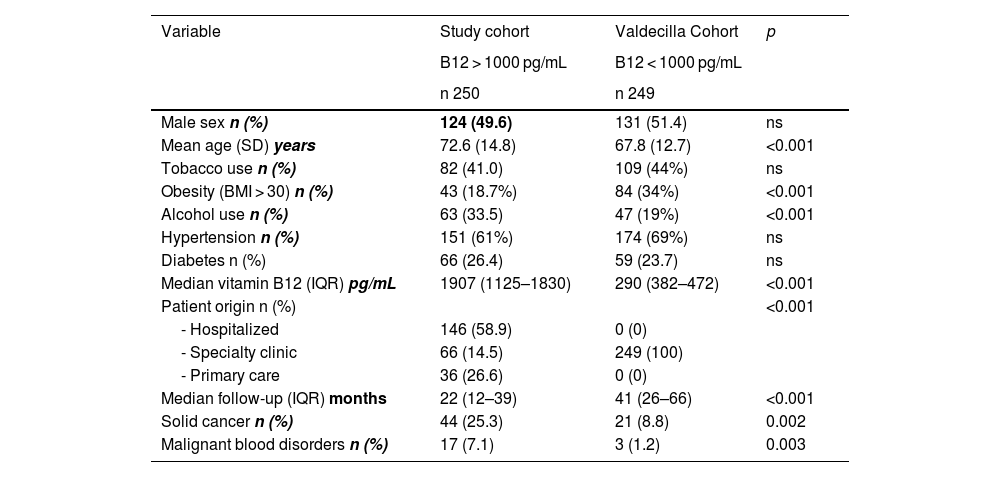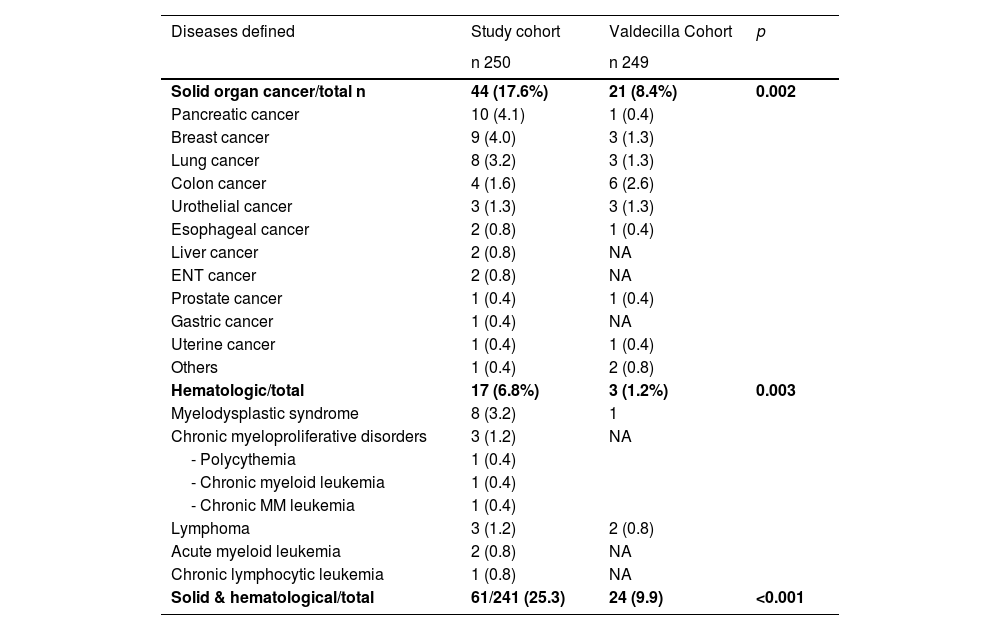Elevated serum levels of vitamin B12 have been associated with oncohematological diseases. However, the relevance of its incidental detection in subjects without a previous diagnosis of cancer is unknown. The aim of this study was to evaluate the relationship between incidental hypercobalaminemia (vitamin B12 > 1000 pg/mL) and the diagnosis of a tumor process in patients without a diagnosis and to establish the risk factors.
Material and methodsRetrospective observational study of a cohort of patients with hypercobalaminemia. The incidence of neoplasms was compared with a cohort of patients with vitamin B12 levels <1000 pg/mL.
ResultsVitamin B12 determinations of 4800 subjects were selected. Of them, 345 (7.1%) had levels >1000 pg/mL. 68 (28.4%) were excluded due to exogenous administration, 12 (5%) due to insufficient data and 15 (3%) due to having an active neoplasia, selecting 250 patients, with a median follow-up of 22 (IQR 12–39) months. Structural liver disease was detected in 59 (23.6%). 18.2% (44 patients) had solid organ cancer and 17 (7.1%) had malignant hemopathy. The average time from the detection of hypercobalaminemia to the diagnosis of cancer was about 10 months. The median until the diagnosis of neoplasia was higher in the high vitamin B12 group (13 vs. 51 months p < 0.001). Hypercobalaminemia (HR 11.8; 95% CI 2.8–49.6; p = 0.001) and smoking (HR 4.0; 95% CI, 2.15–7.59; p < 0.001) were independent predictors of neoplasia in the multivariate analysis.
ConclusionsIncidental detection of serum vitamin B12 levels >1000 pg/mL is high in the population. The diagnosis of solid organ and hematological neoplasia is frequent during the following year of follow-up, with hypercobalaminemia and smoking being predictors of a higher risk of cancer.
Los niveles elevados de vitamina B12 se han asociado a enfermedades oncohematológicas. Sin embargo, se desconoce la relevancia de su detección incidental en sujetos sin un diagnóstico previo de cáncer. Evaluar la relación de la hipercobalaminemia y el diagnóstico de un proceso tumoral y establecer los factores de riesgo.
Material y métodosEstudio observacional retrospectivo de una cohorte de pacientes con hipercobalaminemia. Se comparó la incidencia de neoplasias con una cohorte de pacientes con vitamina B12 < 1000 pg/mL.
ResultadosSe seleccionaron 4800 sujetos con determinaciones de vitamina B12: 345 (7,1%) presentaban niveles >1000 pg/mL. Se excluyeron 68 (28,4%) administración exógena, 12 (5%) datos insuficientes y 15 (3%) una neoplasia activa, seleccionando 250 pacientes; mediana de seguimiento 22 (RIQ 12–39 ) meses. Se detectó: hepatopatía 59 (23,6%), 18,2% (44) presentaron cáncer de órgano sólido y 17 (7,1%) hemopatía maligna. El tiempo medio desde la detección de hipercobalaminemia al diagnóstico fue 10 meses. La mediana hasta el diagnóstico fue mayor en el grupo de vitamina B12 elevada (13 vs. 51 meses p < 0,001). La hipercobalaminemia (HR 11,8; IC95 2,8–49,6; p = 0,001) y tabaquismo (HR 4,0; IC95%, 2,15–7,59; p < 0,001) resultaron predictores independientes.
ConclusionesLa detección incidental de niveles séricos de vitamina B12 >1000 pg/mL es elevada. El diagnóstico de neoplasia órgano sólido y hematológica es frecuente durante el año siguiente de seguimiento, siendo la hipercobalaminemia y el tabaquismo factores predictores de un mayor riesgo de cáncer.
Article
Diríjase desde aquí a la web de la >>>FESEMI<<< e inicie sesión mediante el formulario que se encuentra en la barra superior, pulsando sobre el candado.

Una vez autentificado, en la misma web de FESEMI, en el menú superior, elija la opción deseada.

>>>FESEMI<<<










